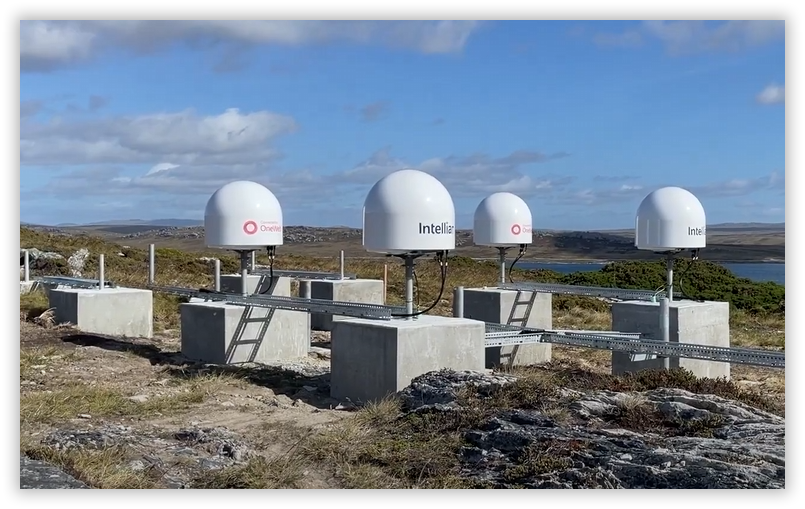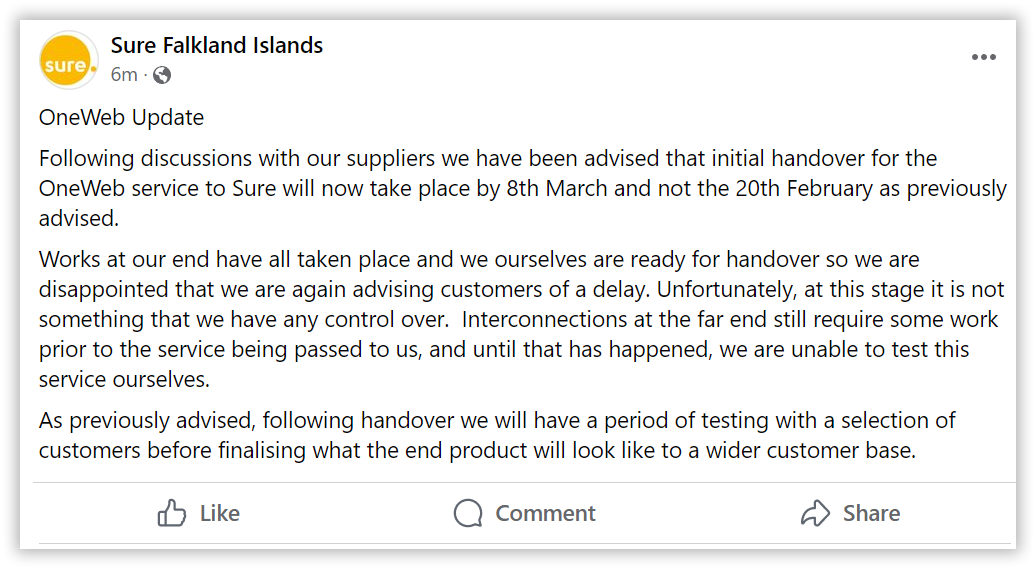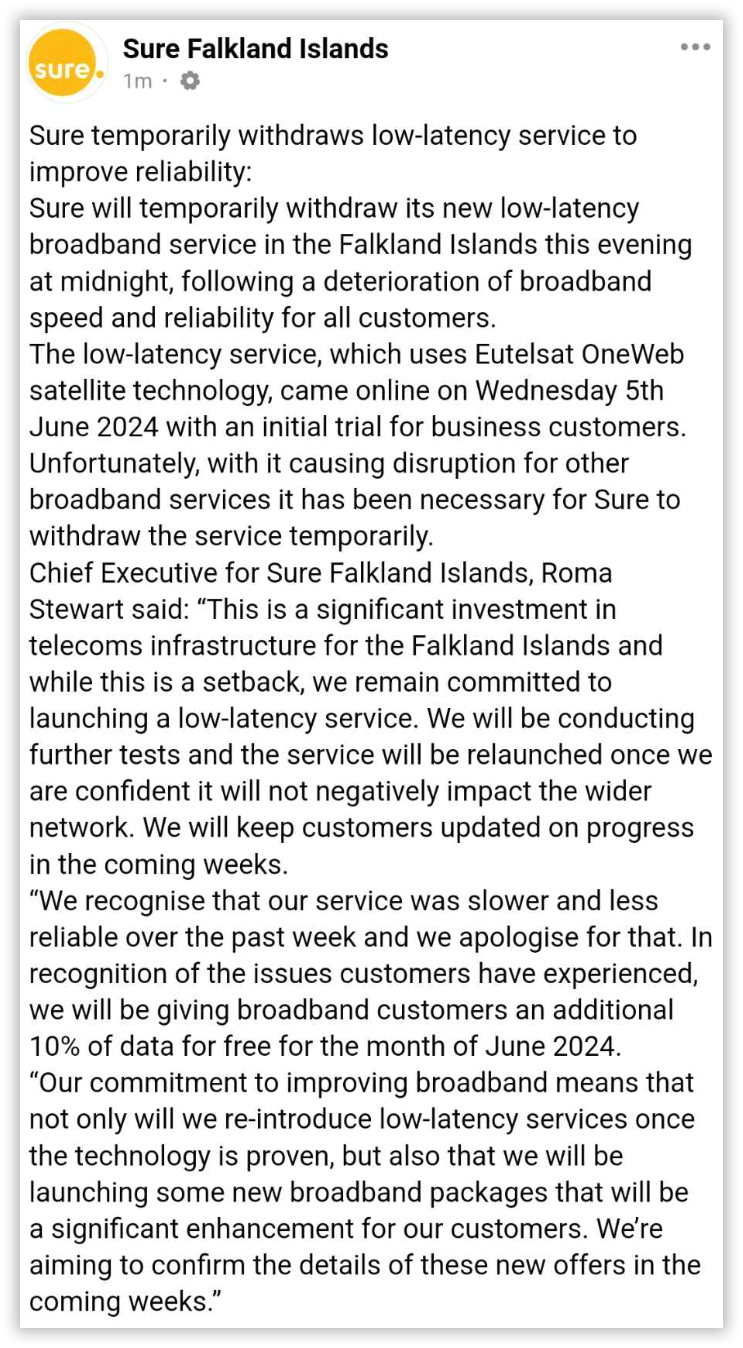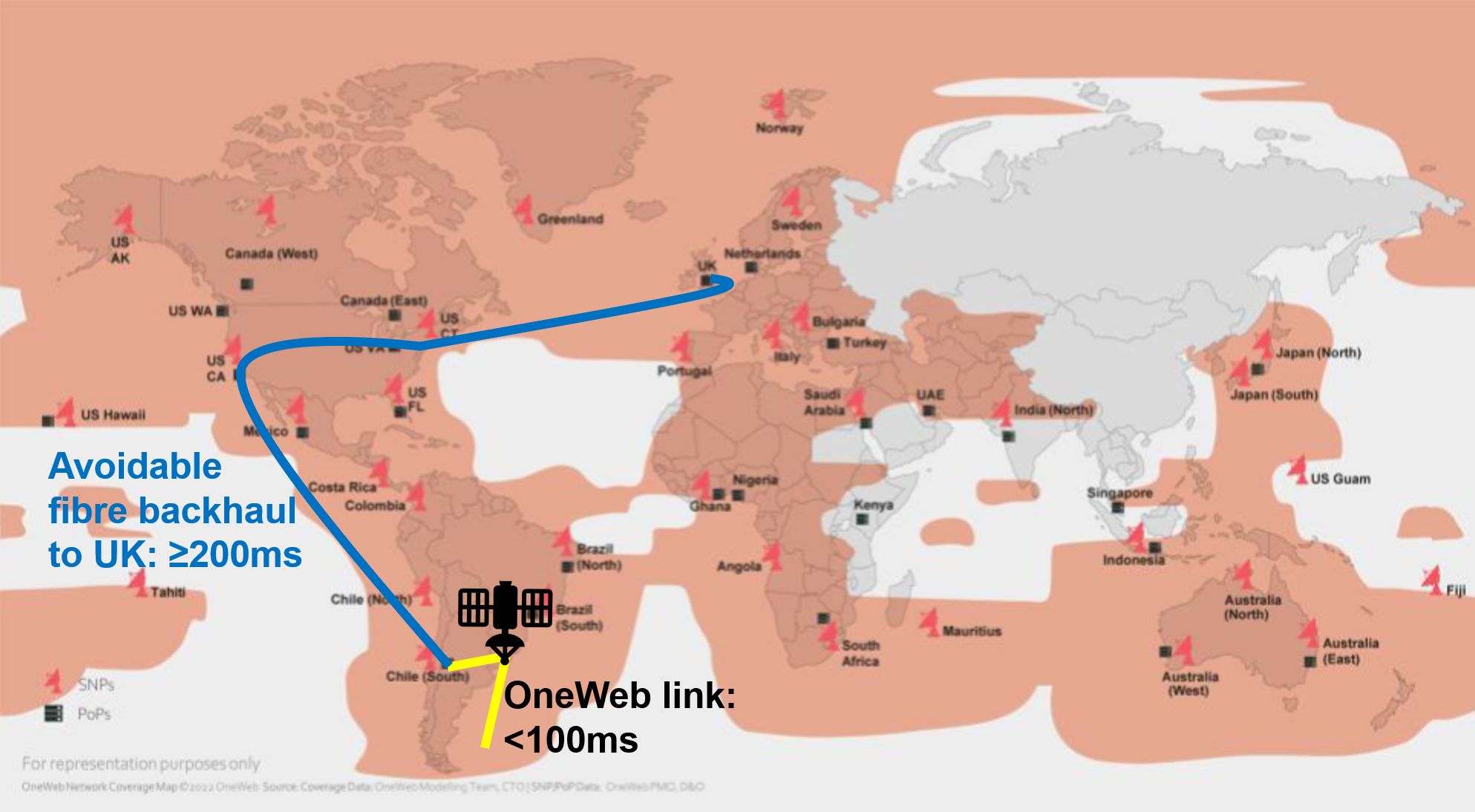
Observations.
This is a long and very technical post, but it is necessary to examine the issues. Before I start, I wish to clarify three points.
- Sure’s ‘low-latency’ LEO service isn’t likely to compete with Starlink from a performance perspective and will probably remain, for some considerable time, the second-choice solution for the Falkland Islands’ low-latency needs to Europe (assuming Starlink use gains legal approval).
- Sure’s ‘low latency’ LEO service round-trip delay to Europe of nearly 300mS, as implemented by Intelsat and Sure Falkland Islands, is unlikely to significantly improve in the near term due to the exceedingly long network backhaul path to Europe. It cannot compete with Starlink’s 70mS latency to Europe for voice and cloud-based services.
- Sure’s ‘low-latency’ LEO service is actually ‘high-latency’. This is not a OneWeb issue per se but is caused by Intelsat’s routing choices or limitations in backhauling the Falkland Islands’ low-latency traffic to the Internet backbone in the UK.

The history of low-latency services before January 2024.
17th November 2022: Low-latency LEO services are first mentioned in a joint press release from the Falkland Islands Government (FIG) and Sure Falkland Islands. Note: This has been abridged.
“Sure, who hold the operating licence for mobile and broadband telecommunications until 2027, has worked with FIG to agree a new programme of rolling improvements and infrastructure investments, including new Low Earth Orbit (LEO) satellite systems.
In summer 2023, customers will further benefit from the introduction by Sure of a new Low Earth Orbit Satellite service, via the OneWeb Satellite constellation. This will reduce latency compared with existing systems, allowing greater use of cloud-based services and other latency sensitive applications.”
December 2023: Intelsat posted an exceedingly optimistic video called: “Delivering Multi-Orbit Satellite Services in the Remote Falkland Islands.
“Intelsat developed an Innovative solution to combine multiple GEO satellites with Leo satellites to deliver a single, optimized, high-capacity service. So what we deliver with Intelsat is a much-improved broadband experience which means very robust bandwidth at any point in time anywhere you are in the Falkland Islands”.
This promotional YouTube video seems to ‘jump the gun’ somewhat and doesn’t really reflect reality as found eight months later.
January 2024: Justin McPhee, then-CEO of Sure Falkland Islands, was interviewed by Falkland Islands Television Service (FITV). The interview focused on why there had been considerable delay in providing a low-latency LEO service.
21st February 2024: Sure Falkland Islands announced a further delay in service launch.


What has happened since April 2024?
For a complete history of events, please read my earlier post.
19th April 2024: The public minutes of the Falkland Islands Government Technology Development Group referenced a discussion about LEO low latency services. This body was set up to discuss the islands’ future Internet needs. It has been abridged.
“xx explained that the system was up and currently being tested which would continue for a number of weeks, meaning it had been delayed being rolled out to the general public. xx noted that Sure was now approaching customers and asking some business customers to trial, which was hoped would start the week commencing 22/04/24. xx noted that they wanted to target businesses that used cloud-based systems, that would be happy to go on the trial, noting that once the trial was finalised then the new system would be rolled out to customers”
6th June 2024: Broadband outages were very severe. The whole island’s broadband service was compromised for over three hours during one of the busiest shopping times of the day. Similar outages occurred on the following days as well.

13th June: Sure, Falkland Islands withdrew the trials of its LEO low-latency service because of the significant outages and the community upset they caused.

19th June 2024. Kris Ball of Falkland Islands Radio interviewed Roma Stewart, CEO and Mark Heron, Chief Technology Officer of Sure, Falkland Islands, in their Stanley offices to understand the issues.
 What caused the major broadband outage on June 6th?
What caused the major broadband outage on June 6th?
Three parties are involved: Sure Falkland Islands, OneWeb and Intelsat.
- Sure Falkland Islands has an exclusive licence until December 2027 to operate communication services on the islands. Sure refers to Intelsat as their “service partner” in the interview.
- OneWeb provides the LEO satellite service connecting the Falkland Islands to their ‘Point of Presence’ (POP) in Santiago, Chile.
- Intelsat has an exclusive agreement with Sure Falkland Islands to backhaul all Falklands Islands’ interactive voice and data traffic to the UK using GEO and LEO satellites.
Intelsat and OneWeb partner to create what Intelsat calls its “Multi-Orbit Strategy“. This may sound complicated (technically, it is), but it consists of Intelsat-developed technologies that automatically steer low-latency interactive, voice or cloud-based app traffic to the low-latency OneWeb LEO satellites. Meanwhile, streaming services are steered to Intelsat’s geostationary satellite. This is the “new Architecture” talked about in the Sure interview. Intelsat says:
“Intelsat’s multi-orbit strategy is designed to provide comprehensive, flexible, and reliable satellite communication services by combining the strengths of both GEO and LEO satellite constellations”.
“Software-Defined Networking (SDN) allows for dynamic routing of data, enabling the network to adapt in real-time to changing conditions and requirements. This ensures that data is always sent via the most efficient path, whether through GEO or LEO satellites.”
This ‘Architecture’ was likely first tested in Intelsat’s London labs, and Sure’s implementation in the Falkland Islands is probably one of its first field deployments. Its would be a very significant infrastructure update for Sure. When Sure made it operational on the afternoon of June 6th, unforeseen problems arose, causing the new Architecture to collapse and forcing Sure to reinstall its old routing regime to restore service.
 A more serious concern: 300mS latency to London.
A more serious concern: 300mS latency to London.
In April, the public minutes of the Falkland Islands Government’s Technology Development Group reported that Sure stated that the Round-Trip (RTT) delay of their low-latency LEO service was found to be 300mS, which was more than they expected.
xx said that currently Sure were discussing with businesses to enable channelling traffic to the lower latency and then start opening this to the general public. xx Asked what the lowest latency that has been tested to. xx confirmed this as 300milliseconds.”
The Sure interview again confirmed the figure of 300mS.
The 300mS delay to Europe is due to Intelsat’s choice of terrestrial path to bring the Falkland Islands’ low-latency LEO traffic to the UK.
OneWeb has a teleport in Santiago, and WonderNetwork Global Ping Statistics data show that the average round-trip delay between Santiago and London is 211 mS.
The route chosen can be seen on the map below:

The total round-trip delay from a Stanley home to London is estimated below.
| Transit Links to London | Latency or delay |
| Sure’s terrestrial network (VDSL or 4G) | 25mS |
| OneWeb constellation (estimate) | 70mS |
| Intelsat & other network, including transatlantic link to London | 211mS |
Total |
306ms |
Intelsat’s selected path to backhaul Falklands Islands’ low-latency LEO traffic to the UK is ruining the OneWeb constellation’s low-latency advantage. Could this result from Intelsat’s lack of ground infrastructure in Latin America? See the footnote for a more detailed explanation.
The major benefit of LEO low-latency satellite technology is that it provides much lower latency than the high latencies experienced on geo satellites. This is very beneficial for delivering high-quality interactive voice or cloud-based business services. What is the minimum latency/delay that would be noticed in conversation?
The International Telecommunication Union’s (ITU) Recommendation G.114 defines the impact of latencies on the quality of voice transmission.
- Ideal: For high-quality voice communication, the ideal one-way latency is less than 150 ms.
- Acceptable: Latencies between 150 ms and 300 ms are generally considered acceptable but will affect the flow of conversation.
- Noticeable: Latency above 300 ms is noticeable and can lead to interruptions and overlapping speech, making conversations more difficult.
 Conclusion.
Conclusion.
While 300mS round-trip latency improves on geo-satellite-based internet and might be acceptable for delivering non-real-time services, it is not typically classified as ‘low latency’ by the standards of most modern interactive and real-time internet services.
Any interactive or cloud-based business service connecting to the UK using Sure’s Falkland Islands low-latency LEO service will experience a 300ms delay, which is as disruptive to conversations as that experienced on Intelsat’s geostationary satellite. Therefore, Sure’s LEO service cannot be considered ‘low-latency’ for European connections, as it offers no significant advantage over the existing Intelsat geostationary satellite-based broadband services. Caveat: It should be remembered that the round-time trip delays to locations in South America will be considerably less due to the shorter paths involved.
Streaming services like Netflix or iPlayer are never routed across a low-latency LEO satellite because it offers no benefits and is more expensive than the Intelsat geostationary satellite. Additionally, the 300ms round-trip delay still negatively impacts the islands’ ability to adopt 21st-century cloud-based services. This issue is already evident in the challenges the local hospital faces, whose software suppliers have adopted cloud-based solutions that need low latencies. However, cloud-based services are too complex for this post and will be covered in a future post.
To quote a recent comment made by an industry colleague, “OneWeb could certainly provide sub-100ms connectivity to the Falklands if Intelsat wasn’t backhauling traffic across half the planet.” and another:
“Obviously tromboning traffic to London and back will completely eliminate the benefits of LEO.”
The Falkland Islands seems to have been a poor choice for using Intelsat’s Multi-Orbit capability, as it does not play to the strengths of OneWeb’s low-latency LEO constellation. Sadly, if Intelsat cannot provide an appropriate shorter path to the UK, Sure’s low-latency LEO service has little credibility for improved communication with friends or colleagues based in Europe.
Of course, these are purely my opinions. I have asked OneWeb, Intelsat, and Sure Falkland Islands for comments, but all declined. I’m most happy to publish updates if any of my assumptions are incorrect.
For a recent update on Intelsat activities, look at their 14th May results presentation.
Footnote
I could be wrong about this, but as far as I can identify through talking with satellite industry colleagues, Intelsat’s problem could be twofold: On the one hand, they don’t have a POP in all of Latin America, and, on the other hand, they don’t have a geostationary teleport in Latin America, where they could land the high-latency traffic from the Falklands, unlike Starlink. Is that the case, I ask?
Intelsat’s LEO and GEO Falkland Islands traffic need to land in proximity to provide multi-orbit services efficiently. The two traffic streams need to be united before they can be sent to the Internet, and Intelsat doesn’t have the infrastructure to do that. If I am wrong in any of my assumptions, I hope that the parties involved will correct me.
Footnote: St Helena
In contrast to the Falkland Islands, OneWeb should work very well on this South Atlantic Island with their LEO satellite ground station up and running by the end of 2024. The project, in collaboration with Sure South Atlantic, aims to enhance connectivity for the island and the surrounding region. The ground station will be located at Horse Point. It will work exceptionally well because OneWeb’s initiative includes taking 10% of St Helena’s capacity on the Equiano subsea cable, which connects Western Europe to South Africa.
Chris Gare, OpenFalklands June 2024, copyright OpenFalklands

https://www.intelsat.com/wp-content/uploads/2023/04/SureSouthAtlanticCaseStudy.pdf
I think one thing that might be a win win proposition that involves SURE is the starlink community gateway.
Intelsat already has a partnership with SpaceX and they can extend it here.
10 Gbps low latency direct to London (or St Helena/ Ascension Island [they might want to drop the data asap to fibre]) over lasers
What’s your ping to London over starlink?
70 ms